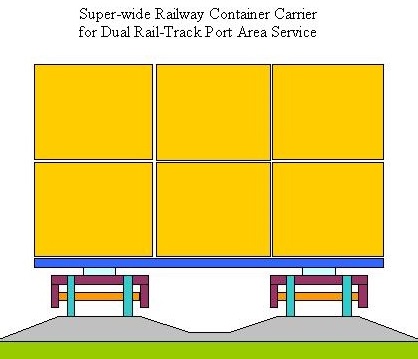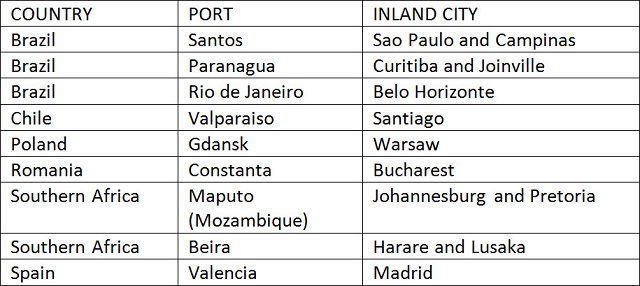
The majority of maritime ports worldwide offer the option of intermodal transfer of containers between maritime and railway transportation, and at some ports, the port railway may serve as the means by which to undertake ship-to-ship transfers of containers.

Railway technology, including parallel railway tracks, offers the possibility of developing super-wide railway cars that can carry large numbers of containers between ships at a transshipment terminal. One option could involve railway cars capable of carrying up to three levels of 40-foot containers placed three abreast and two lengthwise (6 x 3 = 18 containers).
Ports and Beyond
Trains of super-wide railway container carrier cars capable of straddling parallel sets of railway tracks while carrying three or even four levels of containers could shunt the containers between ships moored to an extended quay or even be shunted between quays in different areas of a transshipment terminal. This concept, based on proven railway technology, could be compatible with a future generation of automated cranes that rapidly transferred groups of containers on and off ships. One application would be at major international transshipment terminals and the other would involve inter-city transportation.
Railway Wheel Assemblies
Railway wheel assemblies called bogies or trucks are built with a measure of lateral movement. The spacing between the mid-point of parallel railway tracks can vary between 12 feet in sidings to as much as 18 feet along main lines. A super-wide railway container carrier built to a length of over 80 feet and just over 24 feet in width, measured over the car body, could straddle over parallel railway tracks within a maritime terminal as well as along some main railway lines.
It would ride on four bogies or four railway trucks built to offer just over six feet of lateral movement. A mechanical linkage would assure that the distance between the mid-point and the bogies would remain equal as the bogies readjust to changing spacing between parallel railway tracks.
The super-wide railway cars would feature single central couples between semi-permanently coupled sets of cars, with parallel couplers at the leading and trailing ends. The parallel coupler assemblies would include some freedom of lateral displacement to allow parallel locomotives to pull or push trains of super-wide container carriers.
A train of 30-such railway cars with locomotives at both ends of the train could carry 360 to 540 containers of 40-foot length.
Narrow-gauge Railways
Railways in countries that use the meter-railway gauge or Cape railway gauge of 3’ 6” are restricted to one level of containers, with trains of 50 extended-length railway cars of over 80 foot carrying up to 100 containers.
In countries that operate the international railway gauge of 4’ 8.5” between the rail inner surfaces, double stacked containers become possible where vertical clearance permits. Train stability becomes a cause of concern where narrow gauge railway lines prevail, hence single stacked container operation.
The combination of generous vertical clearances and parallel railway tracks offers and option to countries with narrow-gauge railways.
When it becomes possible for a super-wide railway container carrier car to straddle over parallel railway tracks, double and even triple stacking of containers becomes possible along some railway lines in Southern African countries and countries such as Indonesia, Malaysia, Thailand, Argentina, Chile, Peru, Brazil and parts of India. These railway lines would include generous overhead vertical clearance made possible by the absence of overhead bridges and railway tunnels. Part or all of some railway lines between ports and large inland cities may be possible candidates to operate super-wide container carrier trains.

Future Super Cranes
A recent development in crane technology allows for the simultaneous transfer of two levels of triple empty containers. At a later time, there may be scope to upgrade automated super crane technology to simultaneously transfer fully loaded, double-stacked groups of triple containers between container ship and trains of super-wide railway cars.
At inland intermodal terminals, such cranes could transfer groups of triple containers from railway cars to each of triple parallel parked trucks, with the option of trucks moving on either side of the super-wide trains to reduce the amount of time spent at the terminals.
Railway Sidings and Electric Power
It would be essential to assure that super-wide trains can travel in opposite directions along the same tracks. To achieve this, pairs of parallel sidings would straddle the main line at regular intervals to yield four parallel sets of railway tracks to allow super-wide trains travelling in opposite directions to cross each other. The arrangement would also allow for the combined operation of conventional width and super-width trains along the same railway routes.
At geographic locations where electric traction is preferred, power transmission may have to switch from overhead cable to third rail power distribution.
Future Research
There are railway research institutes in many countries that could build and test scale model super-wide railway container carriers. Scale model railway tracks are readily available at competitive prices to provide a basis for the research.
Some ingenuity and innovation would be required in the development and design of scale-model carriages that would feature 4-sets of railway wheels, with adjacent sets being able to adjust to changing spacing between the track centers. The design would assure that each adjacent wheel set remains at equivalent distance from the carriage center line.
Each wheel set assembly would include standard railway lateral suspension as well as a lateral roller system to allow the wheel sets two meters of lateral movement, that is, each well set would feature one meter of lateral capability. Research would need to develop methods to include amidships groups of locomotives in the middle of super-wide trains in addition to locomotives at the leading and trailing ends of the train.
For port operation, third rail or conduit electrical distribution and automated train movement or remote controlled train movement could assure smooth transfer of containers between ships.
Conclusions
The development of super-wide railway container carriers that straddle parallel pairs of tracks will require ingenuity and innovation. While the technology could operate within the confines of a port or transshipment terminal, there may be scope for the technology to operate along some modified existing railway corridors that include parallel railway tracks and are free from overhead structures. There are several large inland cities around the world that could benefit from super-container trains operating to and from a coastal port.
